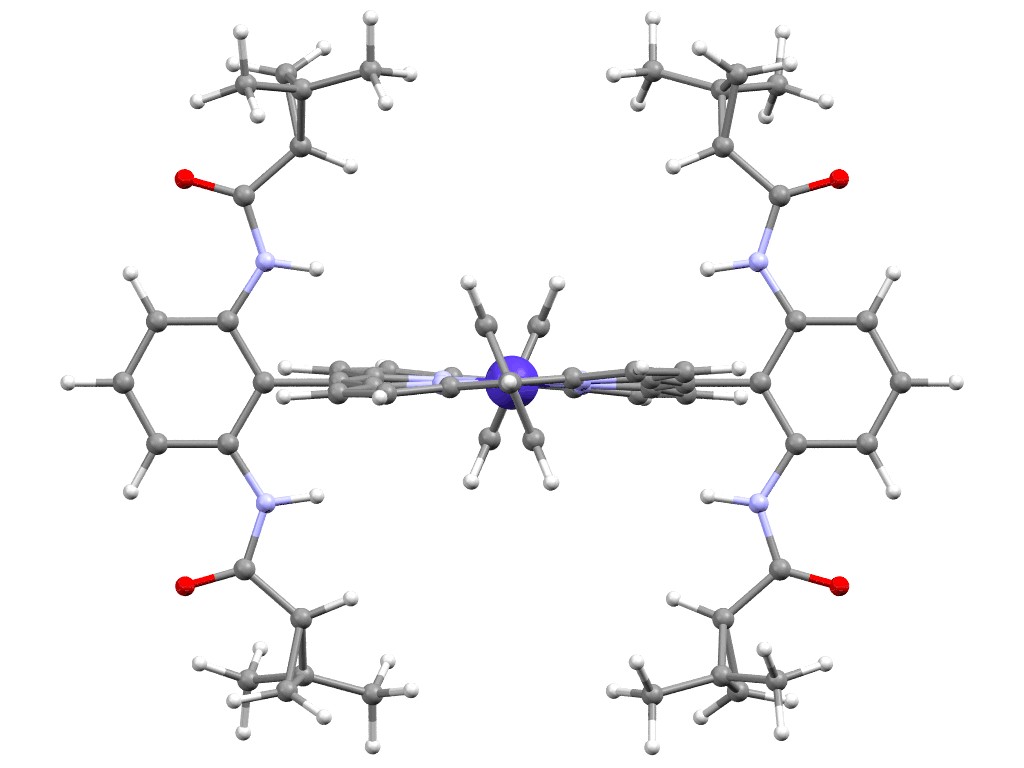A team of Boston College researchers has demonstrated an unprecedented catalytic approach that enables concurrent control of multiple convergences and selectivities in intermolecular amination of allylic carbon-hydrogen bonds in alkenes, a valued but challenging class of organic reactions, the team reported recently in Nature Chemistry.
This new catalytic process allows for selective transformation of the carbon-hydrogen bonds in common alkenes into value-added new alkenes bearing useful amine functionalities.

A model illustrates aspects of an unprecedented catalytic approach, developed by Boston College chemists, that enables concurrent control of multiple convergences and selectivities in intermolecular amination of allylic carbon-hydrogen bonds in alkenes, a valued but challenging class of organic reactions. (CC BY-NC-ND)
Alkenes, hydrocarbons containing carbon–carbon double bonds in addition to carbon-hydrogen bonds, are abundant in nature and readily available. They are commonly utilized for preparation of many other compounds with different structures and practical applications. Alkenes are workhorse molecules in the field of catalysis, attractive to researchers seeking new modes of chemical reactivities critical to scientific advancement.
Most catalytic methods have been developed to target the more reactive carbon–carbon double bonds in alkenes. A catalytic system that can selectively work on the less reactive carbon-hydrogen bond without touching the more reactive carbon-carbon double bond is much less common and its realization is considered as a triumph.

X. Peter Zhang
The Boston College team developed a catalytic approach to realize this challenging transformation through one-electron radical reaction carried out with a catalyst based on the earth-abundant and inexpensive metal cobalt, said lead author and BC Professor of Chemistry Peter Zhang. As such, the catalytic process revealed by the team addresses important issues of sustainability in fine chemical manufacture and related applications in biology, medicine, and materials.
Most metal-catalyzed processes rely on so-called "polar reactivity" wherein chemical reactions involve changes of two electrons at a time. Catalyzing two-electron polar reactions typically requires the use of rare and expensive metal ions, Zhang noted.
The team proposed a fundamentally new approach to better tame the unpredictable behavior of the highly reactive radicals associated with the classic Wohl-Ziegler reaction. The reaction involves the generation of delocalized allylic radicals as the key intermediates for functionalization of allylic carbon-hydrogen bonds in alkenes. However, the classic organic free radical reaction is difficult to control and typically generates a mixture of products, Zhang said.
Guided by the emerging concept of "metalloradical catalysis," in which changes happen one electron at a time during the catalytic process, Zhang and his team developed a new cobalt-based catalytic system that takes advantage of the unique features of homolytic radical reaction. The cobalt catalyst center uses its unpaired electron to preferentially break the carbon-hydrogen bond but not the carbon-carbon bond to generate a delocalized allylic radical. Different from the classic Wohl-Ziegler reaction, this allylic radical is no longer “free” and is closely entangled by the catalyst, Zhang said. As a result, it can form a new carbon-nitrogen bond to produce the desired amine product in a highly controlled and selective manner.
Through the employment of modularly-designed highly-symmetric chiral amidoporphyrins with a tunable pocket-like environment as the supporting ligand, cobalt-based metalloradical catalysis enabled the team to develop a new radical process for chemoselective intermolecular amination of allylic carbon-hydrogen bonds that provide a high degree of selectivity on several fronts in a single catalytic operation, the team reports.
In addition to demonstrating the fundamental principles and unique opportunities of metalloradical catalysis in controlling homolytic radical reactions for molecular construction, the cobalt-catalyzed convergent carbon-hydrogen amination offers a practical and attractive methodology to synthesize valuable chiral α-tertiary amines from the direct use of an isomeric mixture of alkenes as the substrates. This new technology may find useful applications, especially in the pharmaceutical industry.
Zhang said the team was surprised to find out that the catalyst that works the best for the chemical transformation turns out to be the simplest member of ChenPhyrin catalyst family that the team has invented.
“Moving forward, we hope to design the next generation of metalloradical catalysts that can function as powerful precision tools to remove a specific hydrogen atom at will from a complex molecule and then install a nitrogen-based functional group,” said Zhang.
In addition to Zhang, Boston College post-doctoral associate Pan Xu, graduate student Jingjing Xie, and senior research associate Duo-Sheng Wang co-authored the Nature Chemistry report titled “Metalloradical approach for concurrent control in intermolecular radical allylic C−H amination.”
Ed Hayward | University Communications | February 2023



